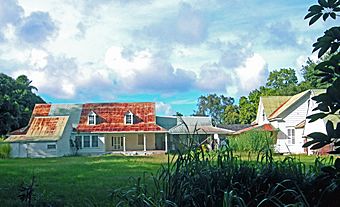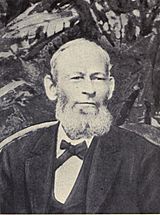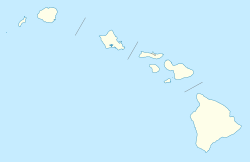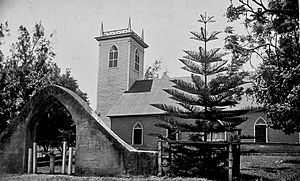Bond District facts for kids
Quick facts for kids |
|
|
Bond District
|
|

Homestead in 2012
|
|
| Nearest city | Kapaʻau, Hawaii |
|---|---|
| Area | 61.8 acres (25.0 ha) |
| Built | 1844 |
| Architect | Isaac Bliss, Elias Bond |
| NRHP reference No. | 78001016 |
| Added to NRHP | March 30, 1978 |
|
Elias Bond
|
|
|---|---|
 |
|
| Born | August 19, 1813 |
| Died | July 24, 1896 (aged 82) |
| Occupation | Missionary, Teacher |
| Spouse(s) | Ellen Mariner Howell |
| Children | 9 |
| Parent(s) | Elias Bond Rebecca Davis |
The Bond District is a group of old buildings in North Kohala on the island of Hawaii. It's a special place because it shows how missionaries lived and worked long ago.
This historic area has three main parts:
- The home of missionaries Ellen and Reverend Elias Bond (who lived from 1813 to 1896).
- The Kalahikiola Church.
- The Kohala Seminary, which was a school for girls.
Contents
Who Were Ellen and Elias Bond?
Elias Bond was born in Hallowell, Maine on August 19, 1813. His father was also named Elias Bond. His grandfather, Colonel William Bond, fought in the American Revolutionary War.
Elias went to Bowdoin College and then to Bangor Theological Seminary. He became a minister. On September 29, 1840, he married Ellen Mariner Howell. The very next day, he became an ordained minister.
The Bonds had 11 children in Hawaii, but only 9 of them lived to be adults. Mrs. Bond passed away in 1881, and Reverend Bond passed away in 1896.
Their Journey to Hawaii
On November 14, 1840, the Bonds sailed from Boston on a ship called Gloucester. They were part of the Ninth Company from the American Board of Commissioners for Foreign Missions. This group sent missionaries to different parts of the world.
They arrived in Honolulu in May 1841. There, Elias saw the Kawaiahaʻo Church being built. The Bonds were then sent to a faraway place on the northern coast of the Big Island of Hawaiʻi. This area is known as the Kohala district.
The Bond House: A Missionary Home
When the Bonds arrived in June 1841, another missionary, Reverend Isaac Bliss, had just finished building the main house for their new home. Elias Bond described it as being made from "native wood and plaster on stone foundation."
By 1842, Elias had made the house bigger. Soon after, they added more parts to the house using stonework. This stonework was similar to the Kawaiahaʻo Church. They used fieldstones held together with mortar made from burned coral.
They added a wash house, foundations for a woodshed and carpenter sheds. There was also an archway and courtyard walls around a large open space. Around 1845, a kitchen wing was added, with a stone foundation and wooden walls.
How the Bonds Came to Own Their Home
By 1848, the Foreign Missions Board wanted to spend less money. So, Bond offered to work without a salary if they would let him have the house he had improved. Instead, the Board asked him to pay them $500 for it.
However, because of new property laws called the Mahele, Bond was able to legally take ownership of the house. He eventually made his property much larger. He bought about 1,400 acres (570 ha) of an ancient land division called ʻIole. Rent from farmers on this land gave him a steady income.
In 1853, another part was added to the house. Its masonry walls were covered with plaster inside and out. Over time, a workshop, other small buildings, and a lily pond were added. The original roofs, which were made of thatch, were replaced with metal.
A Doctor in the Family
Elias's son, Benjamin Davis Bond, became a doctor. He finished medical school in 1882 and came back to live in the family home. In 1884, a doctor's office was added to the house for his practice.
In 1889, Dr. Bond married Emma Mary Renton. A wooden cottage was then built at the east end of the main house for them. A small shed was also made bigger to hold a horse carriage and a single horse. This was so Dr. Bond could be ready for urgent medical calls.
Around 1900, the family added modern bathrooms, rooms for servants, and larger stables. They even had a rock-crusher and power-house. This machine first made gravel for paving the estate's roads from their own quarry. Later, it was used to process macadamia nuts grown on the property.
Kalahikiola Church: A Place of Worship
The first building for Christian missionaries in Kohala was a simple hut. It was built in 1837 but was destroyed by a storm in 1840. The second hut was repaired by Bond, and then replaced with a wooden building in 1846.
That wooden building was also destroyed by strong winds in 1849. The church members then spent five years building a much stronger church. The Kalahikiola Church was finished and dedicated on October 11, 1855. It was made entirely by hand from stone and mortar.
The main part of the church is a rectangle, about 40 feet (12 m) by 80 feet (24 m). A 16-foot (4.9 m) square wooden tower was added around 1858.
The Kalahikiola Church is located a bit south of the Bond homestead. Its name, ka lā hiki ola, means "the day of salvation approaches" in the Hawaiian language. It was also called the "Kohala Hawaiian Church" because services were held in Hawaiian until 1950.
The Church and the Sugar Plantation
By the time the church was finished, fewer people were attending. This was because many people got sick, and others moved away for jobs outside the area. Since Bond owned the land, he started his own "Kohala Sugar Plantation" in 1862. This helped support his work and gave jobs to local people.
He convinced a company called Castle & Cooke to buy 3,000 acres (1,200 ha) of land. The first sugarcane crop was harvested in 1865. By 1867, the plantation had a fairer way of managing workers, unlike some other sugar plantations in Hawaii that had very strict conditions.
The sugar mill was built downhill from the homestead. By the 1880s, the profits from the plantation made Elias Bond the biggest helper for other missions. The plantation finally closed in 1973.
Damage and Repair
In 1973, an earthquake caused cracks in many of the church's stone foundations and walls. But the building was repaired. The church suffered even more damage after the 2006 Kiholo Bay earthquake. One wall was completely destroyed.
The church members decided to rebuild. They used money from insurance and donations. Construction began in November 2008, more than two years after the earthquake. The very thick walls were replaced with concrete blocks. These blocks were covered in plaster to look like the old, uneven stones.
Kohala Seminary: A School for Girls
At first, the Bonds ran separate schools for boys and girls. The boys built their own hut for school. Mrs. Bond taught the girls in their home.
In 1873, after raising about $2500, work began on a new school building. It was located uphill and inland from the church. The girls' boarding school, called the Kohala Seminary, had its first class in December 1874 with 13 students.
Elizabeth M. Lyons was the first Principal. She named the school "Mauna Oliva" after the Mount of Olives. In September 1878, about 30 of the 57 students got a serious illness. Only 47 students were able to finish the school year.
An extra classroom building was added, and the first building became a dormitory where the girls slept. In 1886, Elizabeth Lyons had to leave to care for her father. Another illness outbreak also caused fewer students to enroll.
The school closed for a short time but reopened in 1887. The school's goals slowly changed. At first, it prepared girls to be wives and mothers. Later, it focused on preparing them to be teachers or other professionals. More students enrolled as a high school diploma offered better job chances.
New parts were added to the school in 1890 and 1891. It was also remodeled after a fire in 1894. It was known as the "Select School for Girls" because of its high standards.
When the Kamehameha Schools opened a girls' school in 1894, some wondered if the Kohala Seminary was still needed. However, Kamehameha Schools only accepted Native Hawaiians. Their Hawaii island campus did not open until 2001.
In 1926, the dormitory building was used for girls attending the new public Kohala High School. The seminary finally closed in 1955. After that, it was only used for special private events and as rental units.
Keeping History Alive
Benjamin Bond, Elias's son, closed his medical practice in 1925 and moved to Hilo, Hawaii. Other children born at the homestead included Ellen, George, Elias, Caroline, Julia, and Abbie. The Bond family members are buried in Waianaia Cemetery.
By 1967, the Bond family bought the school building back from the church. It was not being used and had fallen into disrepair.
On July 22, 1977, the Bond District was listed as a historic site for Hawaii. On March 30, 1978, it was added to the National Register of Historic Places listings on the island of Hawaii. After all of Elias and Ellen Bond's children passed away, some of their grandchildren kept the house. They preserved it with its original furniture and used it as a quiet getaway.
Its faraway location made it special. It was the only missionary station in Hawaii owned by one family for over 150 years.
Land was given by Caroline S. Bond on July 19, 1927, for the Kohala public library. It was named the "Bond Memorial Library." A small building from 1929 was replaced by a larger one built in 2009. Dorothy Bond, a descendant of the family, was the first librarian.
The entire estate was bought in 1999 by the New Moon Foundation. They spent several years making the buildings strong and restoring them. Their plans for an educational center were delayed because of the 2006 earthquake damage. As of 2010, some trails in the area were open to the public.




